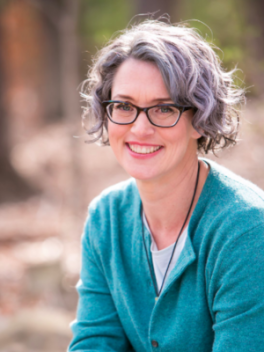Research Spotlight: Margaret Price

Each month, the Communications Team reaches out to members of the Department of English faculty and asks them to elaborate on a current research or creative project they are working on or have recently completed. For this month, we asked Associate Professor and Director of Disability Studies Program Margaret Price to talk about her book project on the experiences of disabled faculty and staff at universities.

In your own words, as the expert that you are, can you explain the overview of your project?
I’m at work on a book titled Crip Spacetime: A Re-orientation to Disability Studies. The book’s core data—its primary texts, so to speak—are interviews with disabled faculty and staff at a wide range of universities. The book’s purpose is partly to help readers understand more about what it’s like to be a disabled employee in higher education—what supports are available, what barriers often come up, what attitudes might be encountered. But the book also has a more philosophical purpose, which is to rethink the ontology of disability.
One of the key findings of Crip Spacetime is that we will never solve access problems equitably as long as we keep trying to “fix” each disabled person’s situation individually. Disability can no longer be understood as a condition that inheres within individuals, nor can we assume that insisting upon individual rights will lead us toward justice. Rather, access should be understood as an issue of shared accountability. This is an argument aligned with a subfield of disability studies, usually called simply “critical disability studies,” which intersects with other fields such as critical race theory and queer theory.
As I’ve explored the possibilities of moving toward a model of access that relies upon shared accountability rather than individual rights, I’ve found that it’s relatively easy to describe but very difficult to enact—especially in academic space, where most of the rewards are predicated upon individual achievement. Thus, I’m currently studying accountability, and the newly popular topic of a “culture of care,” in order to try to figure out how collective accountability might be enacted in academic life. The faculty and staff I’ve interviewed have offered many examples demonstrating that collective accountability does sometimes work (usually in smaller-scale settings). But they’ve also called my attention to ways that the very structure of academic life—including the ways we use and understand time—are inimical to everyday life as a disabled person.
Now, could you shorten this description into one sentence using layman's terms?
The Disabled Faculty Study investigates the experiences of disabled faculty and staff in university spaces—and in doing so, it calls into question what we mean by “disabled,” “space,” “time,” and “access.”
In what ways is your research significant?
This research matters in part because there are hundreds of thousands of disabled faculty and staff members, and yet our experiences are almost never studied. Here’s a little-known fact: The first article our research team produced, which focused on a survey we’d conducted about the experiences of faculty with mental-health histories, was rejected from five different journals (in both education and educational psychology) because, as one editor put it, “faculty disability simply isn’t an area we cover.” Although all five journals published extensively about students with disabilities (including mental, physical, and sensory disabilities), and also published extensively about faculty, something about bringing together the topics of “faculty” and “disability” made the subject seem out of bounds for those journals.
In the five years since—we first submitted our article in 2014—there’s been a small boom in attention to the experiences of disabled faculty. Qualitative and quantitative studies have been launched (including a very large study conducted by the UK Guardian), and “think pieces” have come out in publications including the New York Times and the Chronicle of Higher Education. We are happy to see that there’s now more attention to the situation of disabled faculty and staff, and we are proud to have published findings from a first-of-its kind survey. We eventually submitted the article to Disability Studies Quarterly, and it was published in 2017.
Beyond the issue of there having been very little research about disabled faculty and staff, though, the Disabled Faculty Study is significant because it uncovers questions about the nature of faculty life, and the nature of disability itself, that need to be answered.
Are you working with any colleagues or collaborators?
Yes! I am lucky to have worked with several wonderful people on this project. The initial research team, which conducted the survey described above, was Dr. Stephanie Kerschbaum of the University of Delaware, Dr. Mark Salzer of Temple University, and Dr. Amber O’Shea of Pennsylvania State University (who was a graduate student at Temple when we worked together). Our team put together the survey of faculty with mental-health histories, analyzed the data and produced several publications. In addition to the Disability Studies Quarterly article mentioned earlier, we also published an article in the collection Negotiating Disability: Disclosure and Higher Education, and a free downloadable resource guide titled Promoting Supportive Academic Environments for Faculty with Mental Illnesses.
After the survey was complete, Stephanie and I continued to develop the study. We decided to work with faculty who self-identified as having disabilities of all kinds, and, because we wanted to learn more detailed information from each participant, we moved from surveying to individual interviews. Shortly after interviews began, we were surprised to discover that much of what we’d learned about how to conduct qualitative interviews wasn’t applicable—or had to be significantly reconsidered—when all researchers and participants were disabled. Stephanie and I got excited about that discovery and collaborated on two articles about our adapted methodology—an “interdependent accessible methodology”—which were published in Research in the Teaching of English and the Canadian Journal of Disability Studies.
I also worked with Ryan Sheehan as a research assistant. Ryan helped me think through most the interview transcripts and also helped code some key concepts, including “time” and “accommodation.” He had many sharp insights about the data and raised questions I’d never thought of, such as, “What is the emotional effect on research assistants of reading through transcripts that relate painful or difficult material?” I think I’m most grateful to Ryan for his humor—when you are elbow-deep in hundreds of pages of transcripts, you can always use a good laugh!
Is the project being funded or supported by any individuals or organizations that you would like us to acknowledge?
I’m grateful to the Conference on College Composition and Communication, which awarded Stephanie and me a Research Initiative Grant of $10,000 to help us conduct our interviews, and to the Temple University on Community Inclusion, which shared resources from a National Institute on Disability and Rehabilitation Research (NIDRR) grant as we conducted the survey and wrote the resource guide. I’m also grateful to the Department of English, which awarded me a “Special Assignment” teaching release during Autumn 2019, allowing me to work intensively on the book project emerging from the Disabled Faculty Study.
Where do you see this project going in the future?
Crip Spacetime is now under contract with Duke University Press, so my main job at this point is—finish that book!
What's next for you? What would you like to work on once this project is completed?
While I was working on chapters of Crip Spacetime, I also wrote a sort of side project—an article on service animals that appeared in the Review of Disability Studies in a special forum on “Cripping Care”. While writing that article, I became fascinated by the discourses that surround popular and professional understandings of service animals. For example, from a popular point of view, it’s often surprising that a service animal might be very small and not perform obvious physical tasks. From a professional (service animal trainer’s or handler’s) point of view, a small service animal isn’t a surprise, but there are other assumptions—for example, that a service animal must be consistently “fit” and healthy at all times. I might delve into those questions—the boundaries between human and animal, fitness and unfitness, service and care—for another book project.
